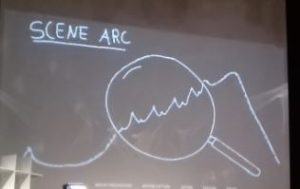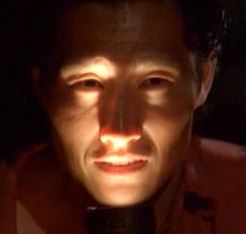Valentin Wirth (Senior Cinematic Editor) from Hangar 13 spoke on Game Access conference about telling visual stories in videogames.
Telling visual stories
How are cinematics created? And how does each step from script to motion capture, through editing and lighting contribute to support story and characters? We will go through our pipeline and explore how each step can help build tension and express your story.
Here are a few notes from the talk.
Scene arc not only for the whole story, but also for moment to moment (scene arc within scene arc).

Write a script, put in drama, background information – who are the characters, what are they thinking, etc. Changes at this point are easier than later. Have a question, conflict and a resolution leading to another question there (“are they going to kiss?” or not… tension).
Animatics. Are fast animated versions of the script. It can be a mobile phone recording, quick sketch or rough 3D animation.
Before doing mocap there is a preparation phase. Probs are just grey boxes to get the sense of scale and object positioning.
Mocap is very fast and direct (vs 3D animation), it allows for any camera angle. Individual actors can be repositioned (offset) later. This is an advantage over film. Get most of it.
Custom cutscene editor tool is used for animation of characters, props, cameras, vfx, etc.
After rough edit in editor there is a “camera lock“. From that point on timing is fixed and people can go on working on various parts of cinematics.
Make sure your camera, edit and lights support your characters, story and what you want to tell.
Optimization is needed. Making sure it runs smoothly. Tweaking shadow quality, number of lights…
Cinematics need a bit of polishing before they are ready (like making sure fingers dont intersect clothing, etc). It takes a while (significant fraction of total time).
VFX like smoke are added at this point. Audio and music is only temporary until audio team replaces it.
Almost final version is “picture lock“ed.
Cinematics are just like movies. Same techniques work in both. Look at movies to learn more. Imitate a lot of reference.
The length of a shot – eg. long shot. Field of view (wide angle – comedic like on drugs, narrow angle on the other hand makes everything look flat). Light direction affects the mood – frontal light for beautiful girls (no wrinkles), side shadows for mystery, high light to show muscles, low angle for creepy feeling.
Use guiding lines and composition to make viewer look at what you want them to look. Separate actors and background. Contrast – compare low contrast of Big Bang Theory with any thriller. Color – warm vs cold colors for different feeling.
Here are all of my posts about Game Access.




Leave a Reply